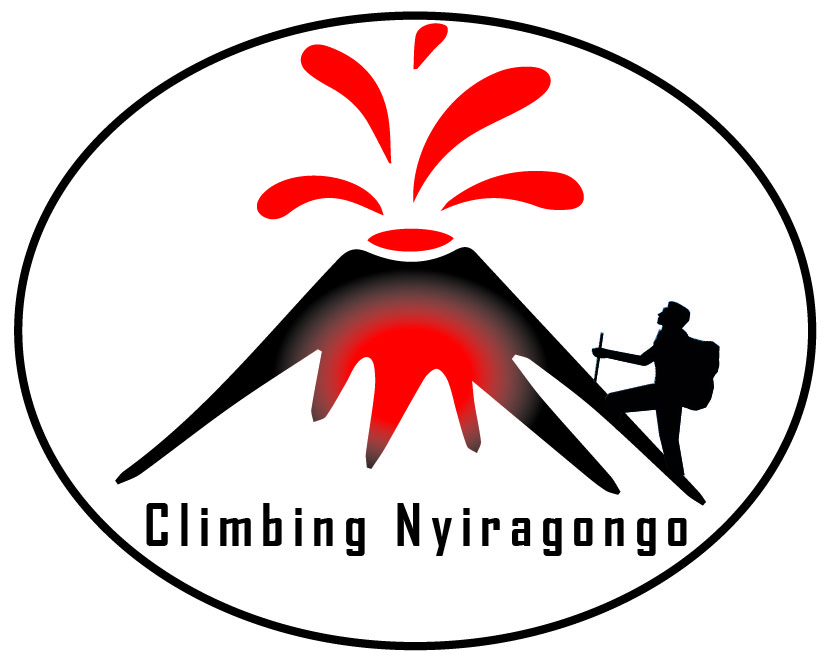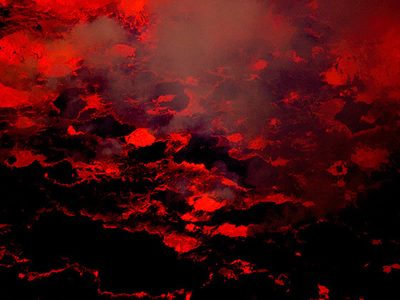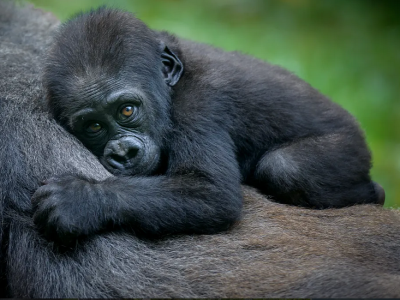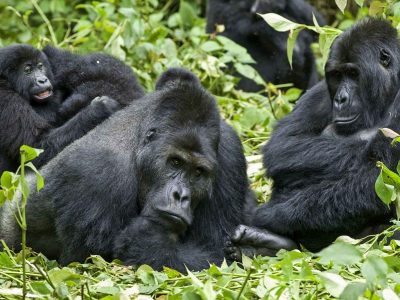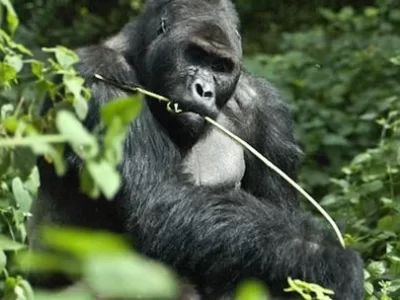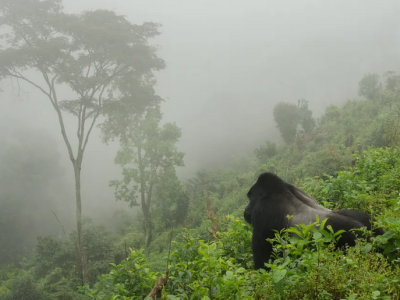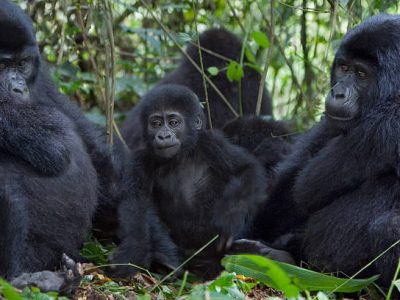Virunga National Park
VIRUNGA NATIONAL PARK
Virunga National Park is situated in the eastern part of the DRC, bordering Rwanda and Uganda covering an area of about 7,800 square kilometers (3,000 square miles). It is Africa’s most bio diverse protected area, home to over one thousand species of mammal, bird, reptile, and amphibian as well as 1/3 of the world’s endangered mountain gorillas found in the park’s southern sector
The park is also home to a chain of volcanoes known as the Virunga Mountains, which include Mount Nyiragongo and Mount Nyamuragira. Mount Nyiragongo is famous for its active lava lake with its last eruption on 22 May 2021, it is a popular attraction for tourists and researchers alike.
Situated in a region which has been deeply impacted by the effects of war and armed conflict for over 20 years, Virunga is currently protected by a dedicated team of 689 Rangers. These local men and women go through intensive training, risking their lives on a daily basis to safeguard the Park’s exceptional wildlife, including the last of the world’s endangered mountain gorillas.
Alongside this essential conservation work, the Park is committed to supporting local communities. It has a vision for responsibly harnessing the Park’s natural resources to create new opportunities for the four million people that live within a day’s walk of its borders. This has been done through focusing on hydro power, sustainable agriculture and fisheries, and tourism to economically transform the region.
History
Virunga National Park was founded in 1925 as Albert National Park. It was the first national park to be established on the continent of Africa, primarily to protect the mountain gorillas living in the forests of the Virunga Massif. It was designated as a UNESCO World Heritage site in 1979.
Attractions and activities in the park
Boat Safaris: The park is bisected by the Semuliki River and is also home to Lake Edward. Boat safaris along these water bodies allow visitors to explore different areas of the park and observe wildlife from a unique perspective. It’s a chance to spot hippos, crocodiles, and a variety of water birds.
Mountain Gorilla Trekking: One of the major highlights of Virunga National Park is the opportunity to go gorilla trekking the 6 habituated gorilla families. Guided tours allow visitors to hike through the park’s forests in search of gorilla groups. This unique experience offers the chance to observe these magnificent creatures up close in their natural habitat.
Volcano Hiking: The Virunga Mountains within the park provide opportunities for adventurous travelers to hike up the slopes of volcanoes like Mount Nyiragongo, with its mesmerizing lava lake, is a popular choice
Wildlife Safaris: Virunga National Park is home to mountain and eastern lowland gorillas, chimpanzees, African bush elephants, colobus monkeys, hippos, lions and okapis. The park’s savannas, forests, and wetlands, provide ample opportunities for wildlife viewing and photography.
Chimpanzee habituation: this tracking is as old as 1987 and was started by zoologist Frankfurt. These animals are closest to humans and this is why people flock these places.
Nature walks: there are several trails in this tropical rainforest leading to different directions and sites. During the walks, tourists encounter buffaloes, elephants and different monkeys.
Landscape viewing: the landscape includes jagged relief of the Rwenzori mountains, the volcanoes, Afro alpine vegetation of tree ferns and dense forests, and eroded valleys, in the ishango and sinda regions
Birding: the park is home to more than 706 bird species including the Albertine rift endemic species, Congolese birds, forest birds among others making it one of the best birding areas. You are accompanied by a knowledgeable bird guide to help you spot the different species.
Virunga mountains
The Virunga Mountains (also known as Mufumbiro) are a chain of 8 volcanoes in East Africa, along the northern border of Rwanda, the Democratic Republic of the Congo (DRC), and Uganda. The mountain range is a branch of the Albertine Rift Mountains, which border the western branch of the East African Rift. They are located between Lake Edward and Lake Kivu. The name “Virunga” is an English version of the Kinyarwanda word ibirunga, which means “volcanoes”.
The volcano chain includes:
Name of mountain Location Elevation in meters Elevation in feet
Mount Karisimbi
Rwanda / DRC
4,507 14,790
Mount Mikeno
DRC 4,437 14,560
Mount Muhabura
Rwanda / Uganda
4,127 13,540
Mount Bisoke
Rwanda / DRC 3,711 12,180
Mount Sabyinyo
Rwanda / Uganda / DRC 3,674 12,050
Mount Gahinga
Rwanda / Uganda 3,474 11,400
Mount Nyiragongo
DRC 3,470 11,400
Mount Nyamuragira
DRC 3,058 10,031
Mount karisimbi
Mount Karisimbi is an active strato volcano in the Virunga Mountains on the border between Rwanda and the Democratic Republic of Congo. At 4,507 meters (14,787 ft), Karisimbi is the highest of the eight major mountains of the mountain range and 5th in Africa
The name Karisimbi comes from the word ‘amasimbi’ in the local language, Kinyarwanda, which means snow. Snow can mostly be found during the dry season in June, July and August on the top of the volcano.
The mountain can be viewed from Uganda, Rwanda and the DRC thus serving as a tourist attraction for all the three countries. From Uganda it can be seen more clearly if you track gorillas in Mgahinga
There are two craters found on this mountain with the mutango crater being the largest in addition to the two (2) kilometer wide Bianca Caldera
A hike on Mt. Karisimbi is considered as one of the leading tourist activities in Rwanda. a hike on Mount karisimbi is commonly combined with a gorilla trekking Safari. By taking this amazing adventure you will be able to encounter various types of wildlife along the way among which are different types of birds, different monkey species like the golden monkey, and if lucky the mountain gorillas you will also get a chance to see but Dian fossey grave (who was a well-known researcher that dedicated several areas of her life when conducting research on the mountain gorillas in this area.
The hike up to the summit is challenging and it will require all participants to be in very good physical shape with proper stamina to be able to take on the challenging slopes of the mountain. As you climb up you will be led by a professional park guide and as you ascend or descend you will follow the pace of the slowest hiker with the hiking group. There are also a number of porters available for hire at the park headquarters who will assist in caring your personal luggage, camping equipment and bags and these can be hired at 20 US dollar each.
The hike begins in the early morning and by 7:00 a.m hikers have started the actual climb after a briefing by the park guide. It takes two (2) days to complete the round trip including the ascent and descent with the starting point being at the bottom of Mount Bisoke. During the approximately 7 hour ascent, you will have a stopover at an altitude of about 3,700m which is almost mid-way, and there you will pitch tent for dinner and the overnight.
The rest of the climb will be completed early morning the next day when you are strong enough. An early hot cup of tea / coffee in the morning the following day for breakfast will be well deserving having spent a cold night up on the mountain. On the second day you will proceed to the final ascent to the peak as you traverse the challenging section that is covered with fog which hinders good visibility, a steeper terrain that experience stronger winds and not to forget the muddy trails. After enjoying some time at the peak you will later begin the approximately 6 hour descent back to the starting point.
What To Pack When Hiking Mount Karisimbi
Rain jacket
Warm sweaters
Trousers or long pants
Gardening gloves
Sunglasses
Hiking shoes preferably with good support on the ankle
Stockings
A hat
A tent, sleeping bag and warm bedding for the overnight
Insect repellent
A first aid kit
Walking stick
Snacks and bottled water
Cost Of Hiking Mount Karisimbi
Every person interested in hiking Mount Karisimbi is required to obtain a hiking permit and the cost of hiking permits on Mount Karisimbi is $400 per person per hike. These permits can be obtained on the day of hiking however holidaymakers are highly advised to book them in advance either from the Rwanda development board or using their trusted travel agent.
Best Time To Hike Mount Karisimbi
Mount Karisimbi can be visited all year round however it can best be hiked during the dry season which begins in the month of June to August as well as in December. Visiting during this time of the year will offer you an opportunity to see the snow that covers the peak of the volcano which on the contrary cannot be seen during the wet rainy season.
Mount Mikeno
Mount Mikeno is an extinct volcanic mountain located in the Democratic Republic of the Congo section of the Virunga Mountains along with Mount Nyiragongo, Mount Nyamuragira, Mount Karisimbi, Mount Bisoke and Mount Sabinyo. At 4,437 meters (14,557 ft) Mount Mikeno is the second highest peak in the Virunga Mountains after Karisimbi, and the 13th highest mountain of Africa. Mikeno means “poor” and is so named for its harsh slopes which preclude human habitation
Mount Mikeno lies completely within Virunga National Park and is known for the critically endangered mountain gorillas that live on its slopes. Expeditions to observe Mikeno gorillas typically leave from the nearby Bukima Patrol Post
Mount muhabura
Mount Muhabura, also known as Mount Muhabura, is an inactive volcano in the Virunga Mountains on the border between Rwanda and Uganda. At 4,127 meters (13,540 ft) Muhabura is the third highest of the eight major mountains of the mountain range,
The mount is characterized by a cone-like shape with volcanic ash and other related materials on the slopes and at the foot. The Volcanic ash supports the group of shrubs and thickets on the sides of the mountains. The Kabiranyuma river/swamp is another prominent feature that separates Mount Muhabura
It offers opportunities to spot rare species of birds and mammals like buffaloes, elephants and Mountain gorillas – especially from the Uganda side. The buffaloes can be dangerous to hikers because they are naturally aggressive but armed rangers are always on hand to scare them away just in case.
If you are climbing mount Muhabura from the Uganda side, you will be met by the resident Guides from the Uganda Wildlife Authority and led to the Ntebeko visitors Centre. A Guide and Ranger is assigned to your group and will lead you all the way up the mountain. If you are moving with heavy luggage or equipment, Porters are available for hire at the foot of the mountain.
Climbing Mount Muhabura starts at around 7 am and takes between 5 to 7 hours to complete.
After the usual briefing, hikers are driven or taken to the starting point of the hike by the park authorities, their personal driver or a Guide/Driver from their Tour company. Permits for climbing Mount Muhabura can be got on the same day as the hike in both Uganda and Rwanda. Hiking Mount Muhabura from the Uganda side involves two major stops before reaching the summit. The first stop is at about 3,117 meters above sea level while the second is at about 3,860 meters above sea level.
At the top, hikers are rewarded with breathtaking scenery, the beautiful countryside, lakes and the other volcanoes within the Virunga ranges like Sabinyo, Gahinga, Karisimbi, Bisoke and Nyiragongo.
The hikers are required to descend down quickly so that they do not encounter forest animals like buffaloes or descend in the dark.
Notes for hikers
Climbing the mountain is challenging and therefore hikers need to know their limits.
Move according to your pace
Do not rush or use a lot of energy in the beginning
Drink plenty of water
If feel any pain stop and admire the beautiful scenery down for a few seconds to remind yourself of what you will behold once you reach the very top.
Mount Bisoke
Mount Bisoke also Visoke is an active volcano in the Virunga Mountains of the. It straddles the border of Rwanda and the Democratic Republic of the Congo, but the summit is located in Rwanda approximately 35 km northeast of the town of Goma, adjacent Lake Kivu.
Bisoke was created by rift action. Bisoke has two recorded eruptions in 1891 and 1957. The most recent eruption happened 11 km north of the summit, and it formed two small cones on the volcano’s north flank. The area where this eruption occurred is still geologically active, suggesting that future eruption at Bisoke is likely.
The volcano has two crater lakes, one being the largest of the range. It is within the Rwandan Volcanoes National Park and the Congolese Virunga National Park. The summit does not gather snow, but is often shrouded in fog.
Hiking this bisoke is not restricted to experienced hikers. Hiking up to the summit takes 6 hours while coming down 2 or more depending on how frequently the hiking team stops for rest while seasoned mountain climbers can take 3 hours
It starts in the morning with briefing from an assigned Ranger at the park offices.You will be required to show your hiking permit, passport and other documentation during the briefing. After registration and briefing, hikers are then transferred from the park offices to the starting point by their company guide or a hired taxi for those traveling on their own. you will be provided with hiking sticks from the park officials armed rangers to escort you up to the summit.you can also hire porters to help with extra luggage.
The permit for hiking Mount Bisoke can be bought on the day of the hike from the park headquarters.
Mount sabinyo
Sabinyo is derived from the Kinyarwanda word Iryinyo, meaning tooth or Old Man’s Teeth,” because its serrated summit resembles worn teeth in a gum line
Mount sabinyo is an extinct volcano, and one of the oldest in the Virunga Mountains north-east of Lake Kivu, one of the African Great Lakes, and west of Lake Bunyonyi in Uganda.
The summit of the mountain, at 3,669 meters (12,037 ft) and its slopes are a slopes of Mt. Sabyinyo are a habitat for the critically endangered mountain gorilla. This mountain is
Hiking the mountain
Hiking mount Sabinyo can only be done from Uganda at the moment because a route has not been created among the sharp ridges in the Congo and Rwanda side. Before the hike, one needs to register at the park office, sign the guest book and clear any payments.
The hike starts with passing through a flat area with several swamps and then ascend to an area with a thick vegetation zones for the first 2390 to 2800 meters. The beauty about climbing to the summit of Mount Sabinyo is that you get to be in three countries (Uganda, Rwanda and Congo) at the same time while having some of the best views you will ever have if the weather permits. From the summit you can see the beautiful Lake Kivu in Rwanda and the Democratic Republic of Congo. You can also see Lake Bunyonyi in Uganda, the Rwenzori ranges of mountains in Uganda, over six mountains of the Virunga region and patches of human settlements.
Notes for hikers
The best time to hike mount Sabinyo is during the dry season.
The summit is very cold and it is important to travel with a warm jacket.
Hiking Mount Sabinyo involves visiting three peaks. It is at peak three that you stand in three countries at a go.
Climbing to the top takes four hours while descending down is also four hours.
It rains a lot during certain times of the year and you need to have protection for your electrical gadgets like phones.
clear visibility at the summit of mount Sabinyo may not be possible during certain months or days of the year because of the clouds (mist).
Permits for climbing Mount Sabinyo cost $85 per person. This includes Guide/Ranger fees and park entrance.
To reach Mgahinga National Park from Kampala, one needs to prepare for an 8 hours journey to Kisoro town and them drive for another 14 km to the park offices or can book a chattered flight from Entebbe Airport in Uganda or Kajjansi to Kinigi in Bwindi and then find their way by road to Mgahinga.
Mount gahinga
Mount Gahinga is a extinct volcano in the Virunga Mountains on the border between Rwanda and Uganda. It lies between Muhabura and Sabyinyo and is the smallest of these three. In Kinyarwanda, the name Mgahinga translates into small pile of stones.
This mountain is home to Mgahinga gorilla national park, a captivating protected area
sitting high in the clouds at an altitude of 2,227m and 4,127m boasting over 76 mammals which include elephants, giant forest hog, bush pigs, bush back, Buffaloes, leopards and a bird checklist of over 180 species and most importantly the gorillas and the golden monkeys.
At the park, one can experience
Batwa cultural heritage
Mountain gorilla trekking and habituation
Golden monkey trekking and habituation
Gorge walk
Painting and art work
Children scouts and adventurous activities
Guided short nature walks for children
By Air: From Entebbe, you can take a domestic flight to Kisoro Airstrip, which is the closest airport to Mgahinga.
By Road: Private Vehicle: You can hire a private vehicle or a 4×4 safari vehicle with a knowledgeable driver. The journey from Kampala to Kisoro takes about 8-10 hours, depending on road conditions and traffic.
Once you reach Kisoro town, the park entrance is about a 20-minute drive away. It’s recommended to arrange transportation with your accommodation or a local tour operator to ensure a smooth transfer to the park.
Mount nyamuragira
Nyamuragira, also known as Nyamulagira, is an active shield volcano in the Virunga Mountains of the Democratic Republic of the Congo, situated about 25 kilometers north of Lake Kivu near Goma. The name is derived from the Bantu verb Kuragira nyamu, meaning to herd animals. The mountain has erupted over 40 times since 1885 hence been described as africas most volcano. there have been numerous eruptions from the flanks of the volcano, creating new smaller volcanoes that have lasted only for a short time like the Murara from late 1976 to 1977.
Eruptions of Nyamuragira volcano
Between 1865 and 2011 there have been 43 confirmed eruptions of Nyamuragira volcano, with an average of 3.5 years between eruptions. Since 1980 there has been an average of one eruption every two years.
On 28 January 1938 a large collapse occurred at the volcano and the crater floor sank by several hundred meters. This was accompanied by the opening of fissures, lava flows and strombolian eruptions.
An eruption of Nyamuragira volcano began on 24th March 1971 from Rugarama cone. Rumbling was heard from a distance of 10 km and a glow visible from 50 km.
Kitazungurwa eruption started on 16th July 1986, on the southern flank of Nyamuragira volcano and lasted 36 days. A 1 km wide, 2 m high lava flow traveled south. The total volume of erupted products is estimated to be 50 million cubic m. During the 1986 eruption, the chemical composition of the erupted products became more mafic.
In 1989 an eruption at Nyamuragira volcano began at the summit and later changed to a flank eruption.
Seismic activity has increased near Nyamuragira volcano in the Democratic Republic of Congo in April 2009. According to scientists at Goma Volcano Observatory, Nyamuragira volcano will be in eruption in the next two or three months.
At dawn of 2 Jan 2010, the volcano began spewing lava flows and these can be seen on satellite photographs reaching 25 kilometers south-west of lake kivu, about 22 kilometers north west and 35 kilometers north- north-east.
On 5 November 2011, the eruption produced a 400-metre high column of lava, and it is said to have been its largest eruption in 100 years.
In 2014-16, An active lava lake was present at Nyamuragira volcano for the first time in 50 years.
In 2017, Satellite images showed hot spots at Nyamuragira volcano in early 2017, indicating ongoing eruptions.
During the period 2018-22, eruptions have continued at Nyamuragira volcano and Satellite images show hot spots at the crater.
Hiking
Hikers with heavy luggage can hire porters and walking sticks will be picked here to help balance during the hike.
takes 5-6 hours and it’s the armed ranger guides that take the hikers through the best hiking trails.
While hiking Mount Nyamuragira, the hikers do spot different park mammals, primates, and birds.
needs one to be physically fit as it takes you through very steep slopes, rugged terrain, and thick vegetation cover.
At the summit, you will have great views of the lava lake, surrounding places such as Virunga national park, lake Kivu, mountain Rwenzori, and Virunga ranges.
Hikers that are interested in having an overnight stay at the summit can use the bungalows and those that want to can do so.
hiking permits can be bought from Virunga national park even on the day of trekking
climbing mount Nyamuragira can be done all year round but the best time to hike is between June to September and December to February
Hikers should carry waterproof hiking shoes, a pair of gaiters, gardening gloves, cotton stocks, scarf, a rain jacket, long-sleeved pants, long-sleeved shirts, insect repellents, a camera, a pair of binoculars, sunscreen, sunglasses, packed lunch, energy-giving snacks, drinking water bottle, face mask, sanitizer, and first aid kit.
Experiences in the park
Nyiragongo climbing
Nyiragongo is an active volcano located in the Democratic Republic of Congo. Climbing Nyiragongo is a popular adventure activity for tourists and nature enthusiasts. However, it’s important to note that the volcano can be dangerous and requires careful preparation and planning. Here are some essential details and tips for climbing Nyiragongo:
Permits: To climb Nyiragongo, you need to obtain a permit from the Virunga National Park authorities. It’s advisable to book your permit in advance, as there is a limit to the number of climbers allowed each day. A permit goes for USD300
Guides and Porters: It’s mandatory to have a certified guide accompany you during the climb. Guides are knowledgeable about the terrain and can ensure your safety. Porters are also available to help carry your equipment and supplies.
Physical Fitness: Climbing Nyiragongo requires a moderate level of physical fitness. The trek to the summit is challenging, involving steep ascents and descents. It’s recommended to engage in regular exercise and be prepared for a strenuous hike.
Equipment: You’ll need proper hiking gear, including sturdy hiking boots, warm clothing (as temperatures drop at higher altitudes), a waterproof jacket, gloves, a hat, and a headlamp for the overnight stay at the summit. It’s also essential to bring enough food and water for the climb.
Accommodation: At the summit, there are basic shelters with bunk beds where climbers can spend the night. These shelters provide rudimentary amenities, such as mattresses and blankets. It’s advisable to bring your own sleeping bag for added comfort and warmth.
Safety Considerations: Nyiragongo is an active volcano, and volcanic activity can be unpredictable. Before embarking on the climb, it’s important to check with the local authorities and guides about the current volcanic conditions and safety recommendations.
Duration: The climb to Nyiragongo’s summit usually takes around 4-6 hours, depending on your fitness level. Once at the top, you’ll have the opportunity to witness the mesmerizing lava lake. The descent usually takes 3-4 hours.
Altitude Sickness: The summit of Nyiragongo sits at an elevation of about 3,470 meters (11,380 feet), which can cause altitude-related issues. It’s recommended to acclimatize properly, drink plenty of water, and consider taking altitude sickness medication if advised by your doctor.
Security: The Democratic Republic of Congo has experienced periods of instability and conflict in certain areas. It’s essential to stay updated on the security situation and follow the advice of local authorities and tour operators regarding travel to Nyiragongo.
Respect the Environment: When climbing Nyiragongo, it’s important to follow responsible tourism practices. Respect the natural environment, do not litter, and follow any instructions or guidelines provided by the park authorities.
Congo gorilla trekking
The Democratic Republic of Congo is the only countries were visitors can track both mountain gorillas and their lowland cousins in the wild. It is the best country for seeing wild eastern lowland gorillas. Lowland gorillas can also be seen in zoos around the world while the mountain gorilla can only thrive in the wild. Lowland gorillas in DR Congo can be tracked at the Kahuzi Beiga National Park while the mountain gorillas are found in Virunga National Park.
Gorilla Tracking in Virunga National ParkMountain gorillas are generally larger in size than lowland gorillas with darker and thicker coats that are designed to help them survive in cold high altitudes. Both sub-species feed on leaves, tree shoots and fruits. Both subspecies live in families/groups led by a dominant male silverback that is responsible for the safety of the rest of the group members and keeping unruly individuals in check. Mountain gorilla groups are generally larger with over 30 individuals at times. The males in both gorilla sub-species stay with the group longer while the females usually leave to join other silverbacks or groups once they reach maturity.
Rwanda gorilla trekking
The volcanic range which spans Rwanda, Uganda and the Democratic Republic of the Congo is home to the endangered mountain gorilla. Tracking gorillas in Rwanda is safe and relatively accessible.
At the latest count, there are approximately 1,000 mountain gorillas in the wild, with 604 in the Virunga Massif. The population is slowly increasing, thanks to concerted efforts between our governments, communities and NGOs.
There are twelve gorilla families living in the Volcanoes National Park, which are fully habituated, with a few others habituated solely for scientific research. The groups, or troops, consist of at least one silverback along with several females and youngsters.
With only 96 permits available each day in Rwanda, it is highly recommended to book in advance, either online or via a reputable tour operator.
Visitors gather at the Volcanoes National Park headquarters in Kinigi at 7am, and are allocated a family group on the day according to fitness levels, as well as being briefed on protocols and rules for visiting the gorillas.
The families are known as Susa, Igisha, Karisimbi, Sabyinyo, Amahoro, Agashya, Kwitonda, Umubano, Hirwa, Bwenge, Ugyenda and Muhoza.
Hikes up to their various locations can last anything from 30 minutes to four or more hours, reaching an altitude of between 2,500m and 4,000m. Porters are available to carry backpacks and cameras, as well as to offer a helping hand along the route.
For those interested in tracing the footsteps of Dian Fossey, her tomb is a 30-minute drive from the park headquarters and then two or three hours hike through the forest, to above 3,000m altitude.
Uganda gorilla trekking
Gorilla trekking in Uganda is done in Mgahinga gorilla national park and Bwindi impenetrable national park.
Bwindi Impenetrable National Park, a remarkable protected area located in southwestern Uganda, Covering an area of approximately 321 square kilometers, is best known as the natural habitat of the endangered mountain gorillas covering over 400 of them
Bwindi impenetrable forest reserve, gazetted in the year 1942 and in 1992 it was upgraded to Bwindi Impenetrable national park.
Gorilla trekking in Bwindi
Gorilla habituation and gorilla trekking are the two famous activities in this park and are done in four sectors namely:
Rushaga
Buhoma
Ruhija
Nkuringo
Gorilla habituation is Gorilla habituation is the process of gently introducing wild Mountain Gorillas to the sight and presence of humans for research, care and conservation purposes usually for 4 hours. In Bwindi, habituation is particularly done in Rushaga.
The process starts every early morning and therefore requires tourists to get up earlier and prepare for the day. It starts at 6;30am with briefing from the parks guide and then set off to meet the gorillas at 7am.
The experience takes about half or full day depending on the location of the gorillas that day and tourists get to spend 4 hours with them once cited.
A gorilla trekking permit costs USD1500 per person per experience.
Gorilla trekking
Gorilla trekking is an outdoor activity where tourists are allowed to see mountain gorillas for one hour after purchasing a permit.
Gorilla trekking permit goes for USD700 per person per experience
Kayaking on lake kivu
lake Kivu is one of the African Great Lakes. It lies on the border between the Democratic Republic of the Congo and Rwanda, and is in the Albertine Rift, the western branch of the East African Rift. Lake Kivu empties into the Ruzizi River, which flows southwards into Lake Tanganyika.
Kayaking on Lake Kivu is one of the most exciting experiences in Rwanda. Get a chance to paddle at your own pace with single or double-seater kayaks while exploring and uncovering the hidden beauty of Lake Kivu’s shores and taking in views of the beautiful hilly backdrop, surrounding sceneries,
You can spend a day kayaking on Lake Kivu, and see the sights of Rwanda’s largest and Africa’s 6th largest Lake with a local guide. After starting from Gisenyi, Kibuye or any of the Resorts (such as Cleo Kivu Hotel), you’ll paddle along the banks, passing the small Islands and watching birds darting in and out of the woodlands while fishermen prepare their nets during the day for casting by sunset.
While kayaking excursions on Lake Kivu can be made all year round, the best time is from December to February and June to September because this is a dry season when water levels have reduced but be prepared for unexpected occurrences like winds and rains. Some of the must-have things for this adventure include sunglasses, a safari hat, backpack, sunscreen, a good camera, binoculars, a rain jacket, any clothes that you don’t mind getting wet, and enough drinking water.
Prices are $60 for tourists, $48 for Rwandan residents and $36 for Rwandan citizens.
The clear, clean lake has an irregular shoreline, with plenty of sandy beaches, as well as little islands to investigate. There are no hippos or crocodiles, making for safe paddling.
The water temperature ranges from 23 to 27 °C throughout the year
Nature walks in Virunga
nature walks in Virunga national park are usually done after a main tourism activity like mountain gorilla trekking and a hike to Nyiragongo volcano. In most cases, its an optional activity done in afternoon & evening hours
The walks in Virunga national park can take you to various areas like the Senkwekwe Gorilla Orphanage center that is located in Rumangabo near the park headquarters. This center is a home to several gorillas that were saved from being trafficked poachers.
the park can be visited through the year however, the best time for this activity is during the dry season of June, July, August, September, December, January and February. During the dry months, the trails tend to be dry to make visitors hike with minimal challenges. The shrubs in dry seasons are usually short to enable guests on nature walk spot a number of animals and bird species and also take clear photos.
Birding in congo
Birding in the Congo, specifically the Democratic Republic of the Congo, offers a unique and rewarding experience for birdwatchers. The country is home to a rich avian diversity with over 1,000 bird species, including many endemic and rare species. Here are some highlights and important information for birding in the Congo:
Virunga National Park: Virunga is not only famous for its mountain gorillas but also offers excellent birding opportunities. The park is home to several endemic species such as the Ruwenzori turaco, Rwenzori batis, Grauer’s swamp warbler, and many others.
Okapi Wildlife Reserve: Located in the northeastern part of the country, this reserve is known for its lush rainforests and is a habitat for the elusive and rare okapi. Birding in the Okapi Wildlife Reserve allows you to spot species like the Congo peafowl, African green broadbill, and yellow-billed barbet.
Salonga National Park: As one of the largest tropical rainforests in the world, Salonga National Park provides a habitat for numerous bird species, including the Congo peafowl, Congo bay owl, and Nkulengu rail.
Parc National de la Garamba: Situated in the northeastern part of the country, this national park offers a diverse range of birdlife. Species like the shoebill, black-collared lovebird, and carmine bee-eater can be spotted here.
Birding Guides and Conservation: It is recommended to hire experienced birding guides who are familiar with the local bird species and their habitats. They can help you locate and identify the various birds in the Congo. Additionally, birdwatching in the country contributes to conservation efforts by raising awareness about the importance of protecting these unique species and their habitats.
Safety Considerations: Before planning a birding trip to the Congo, it is crucial to stay updated on the current security situation and travel advisories. Some regions in the country may have travel restrictions due to political unrest or safety concerns. It is advisable to consult with local authorities and experienced tour operators to ensure a safe and enjoyable birding experience.
Remember to bring appropriate birding equipment such as binoculars, a field guide specific to the region, and appropriate clothing for the local climate. Birding in the Congo can be a challenging but immensely rewarding experience, allowing you to discover a wide array of unique and beautiful bird species in their natural habitats.
Senkwekwe gorilla orphanage
The Senkwekwe Gorilla Orphanage is a sanctuary for orphaned mountain gorillas located in Virunga National Park in the Democratic Republic of the Congo. It was established in 2009 and is named after a famous silverback gorilla named Senkwekwe, who was killed by poachers in 2007.
The orphanage serves as a safe haven for mountain gorillas that have been orphaned due to various reasons, such as poaching, illegal wildlife trade, or the loss of their parents to natural causes. The main objective of the orphanage is to rehabilitate and care for these orphaned gorillas, with the ultimate goal of reintroducing them back into the wild when they are ready.
At the Senkwekwe Gorilla Orphanage, the gorillas receive specialized care from a dedicated team of veterinarians, caregivers, and conservationists. The staff provides the gorillas with proper nutrition, medical treatment, and a nurturing environment to help them recover from the trauma they have experienced.
The orphanage also plays a crucial role in raising awareness about the conservation of mountain gorillas and the threats they face. By showcasing the plight of these orphaned gorillas, the orphanage helps educate the public about the importance of protecting and preserving their natural habitat.
Visitors to the orphanage have the opportunity to observe the gorillas and learn about their conservation firsthand. The experience provides a unique insight into the lives of these magnificent creatures and the efforts being made to ensure their survival.
It’s important to note that due to the political and security situation in the region, access to the Senkwekwe Gorilla Orphanage may be restricted at times. Therefore, it’s advisable to check the current travel advisories and guidelines before planning a visit.
Accommodation in the park
Mikeno Lodge: nestled within the Mahura Forest at the Park headquarters in Rumangabo and is prime position for spectacular views across the beautiful Albertine rift. The surrounding area abounds with wildlife and guests can enjoy seeing many species of endemic birds, blue and colobus monkeys, olive baboons and if one is lucky, the elusive bush buck.
Nyiragongo summit: this is a basic type of cabins built of wood designed to keep you warm and dry after a long day trip. The shelter is strategically located so that it offers stunning views of lake kivu, on the opposite side of the ridge from the crater of Nyiragongo volcano
Serena hotel Goma: this luxury pan, overlooking Lake Kivu, has an Olympic-sized pool and 5-star accommodation and service. The hotel provides tantalizing local cuisine and rich history and culture set the Democratic Republic of Congo. It is not located in the park, but takes an approximate 2 to 3 hours to reach it.
Kibumba tented camp: is the main accommodation for gorilla trekking in Virunga and is located on the misty slopes of Mount Mikeno. It’s a budget friendly lodge and friendly in all way aspects especially for those that want to experience mountain gorillas in Virunga and Nyiragongo areas. It is composed of 18 traditional safari style tents, all of which contain en-suite bathrooms, running hot water and flush toilets and electricity.
Kibuma tented camp: situated near the park, the camp offers spectacular views of the Virunga with the view of mt Mikeno in the south. Here one sleeps in a lavish tent with an adjourning bathroom and running water, relatively large comfortable bed with hot water bottles. Guests here can utilize 24 hr electricity in the main building since there is none in the camp. The camp serves decent and fresh meals with fresh vegetables availed esp for vegans or vegetarians
Linda hotel: Located on the shores of lake kivu, this budget hotel provides spacious rooms with en suite toilets, hot running showers and other facilities and some with balconies.
Best time to visit the park
The most popular time to travel to Visit is during the months of July through to September and by far the driest months of the year. However, being a tropical rainforest, it can still rain in the dry seasons therefore a tourist should always check for weather updates and prepare accordingly.
How to get to the park
Virunga National Park has multiple entry points, so you need to decide which one you want to use. The main entry points are:
Goma: This is the most common entry point and is accessible by road and air. Goma has an airport, Goma International Airport, with domestic and international flights.
Bunagana: This entry point is near the Uganda border and is accessible by road
Once you have selected your entry point, you need to decide how you will travel there. The options include:
Air: If you are coming from outside the region or far away, you can fly to Goma International Airport. Many major airlines offer flights to Goma.
You can also fly into Kigali International Airport and take the 3+ hour taxi ride to the border crossing at Gisenyi, Rwanda/Goma, DRC. From here, a 30km ride is all it takes to the park’s entrance.
Virunga National Park is a gem nestled in the eastern part of the Democratic Republic of Congo. Spanning over 7,800 square kilometers (3,000 square miles), it is Africa’s oldest national park and a UNESCO World Heritage site. The park is renowned for its diverse ecosystems, captivating landscapes, and extraordinary wildlife, including the critically endangered mountain gorillas.
Upon arrival at Virunga National Park, our clients are immediately immersed in its natural beauty. The park is a tapestry of lush rainforests, bamboo forests, afro-alpine meadows, and towering volcanoes, including the iconic Mount Nyiragongo. The park’s breathtaking scenery serves as a constant reminder of the raw power and awe-inspiring forces of nature.
As our clients venture into the park, they have the opportunity to encounter its remarkable inhabitants. Virunga is home to approximately one-fourth of the world’s remaining mountain gorilla population, making it a haven for these gentle giants. Gorilla trekking is a highlight of any visit to the park, allowing our clients to witness these magnificent creatures in their natural habitat and forge a deep connection with them.
Beyond gorilla trekking, Virunga National Park offers a myriad of other attractions. Our clients can explore the diverse flora and fauna through guided nature walks, birdwatching excursions, or wildlife safaris. The park is also home to other primates such as chimpanzees and golden monkeys, as well as a rich array of bird species.
For those seeking adventure, a climb to the summit of Mount Nyiragongo is a must. This active volcano showcases a mesmerizing lava lake that creates a surreal and unforgettable experience. The challenging ascent rewards trekkers with panoramic views of the surrounding landscapes and the opportunity to witness the fiery glow of the lava lake at night, a truly awe-inspiring sight.
Virunga National Park is not only a haven for nature enthusiasts but also a testament to conservation efforts. The park’s dedicated rangers and staff work tirelessly to protect its wildlife, preserve its ecosystems, and support the local communities. By visiting the park, our clients contribute to its conservation and help sustain its invaluable biodiversity for future generations.
As a Climbing Nyiragongo company, we strive to provide our clients with an authentic and enriching experience in Virunga National Park. We ensure their safety, comfort, and enjoyment throughout their journey, creating memories that will last a lifetime. Our expert guides and staff are passionate about the park’s conservation and cultural heritage, sharing their knowledge and creating meaningful connections with our clients.
A trip to Virunga National Park with us is an opportunity to witness the wonders of nature, connect with wildlife, and contribute to the preservation of this remarkable ecosystem. It is an adventure that leaves a lasting impact on the hearts and minds of our clients, fostering a deep appreciation for the beauty and importance of protected areas like Virunga.
